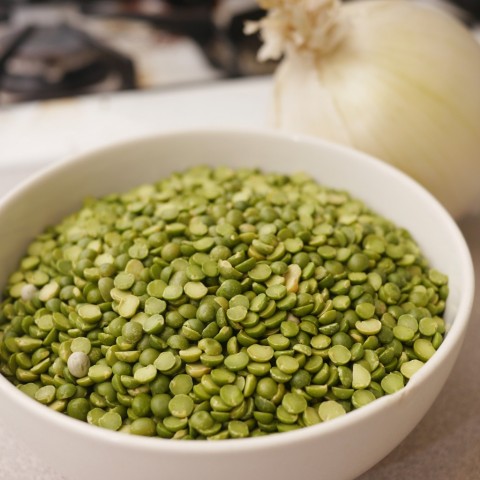Split pea soup has a slightly unfortunate place in the landscape of American popular culture. Especially, I think, for fans of classic horror. Just to mention it in the same paragraph as Linda Blair or Jason Miller is enough to evoke the scene in The Exorcist. It’s enough for us to recall — with a vivid, sickening churn of the stomach — that moment when Father Karras challenges the poor, possessed Regan.
If that’s true, Karras insists, if my mother really is in hell, and you’re really the Devil, you must know her maiden name. What is it? What is it?
He steps forward to drive home his point, and Blair’s response comes in the form of liquid. A green, gloppy, almost laughably gross bucketful, complete with a splattering sound effect.
Apparently, that scene’s soupy punchline, and Jason Miller’s more than convincing shocked, horrified, and disgusted reaction, are so perfect in part because the whole setup was as much a surprise to the actor as it has been to audiences. Director William Friedkin, according to the Wikipedia, told Miller that pea soup would hit him in the chest rather than the face, leaving him largely unprepared. It’s a technique reminiscent of some directors from the old Hollywood directing style, the Wikipedia asserts. But it seems to me that the article might save a few words and just say, instead, that it’s a jerk move.
At any rate, it’s gone a long way to position split pea soup in the mental landscape of a whole lot of moviegoers. And not, I think, in a way that says I’m a delicious and nutritious part of a wholesome winter dinner.

I’d like to position my split pea soup … um … elsewhere.
Mine is a variation on a family tradition — something that my mother made often when I was growing up, that was always a big hit in our household, and that I have resisted making myself over the years, not because of what happened to Father Karras in The Exorcist, but because I consider the recipe to be hers. Why attempt split pea soup myself, I have occasionally thought, when mine surely won’t be as good? Why not wait for those too-rare times when I get to go visit, and enjoy my mother’s rendition of the recipe, then?
But here’s the thing: it’s been awfully cold for the past month and more, here in Philadelphia. And the field of seasonal local vegetables of the above-ground sort has grown awfully thin. There have been lots of beets and turnips, and the occasional potato. And the dull drudgery of roasted root veggies is beginning to wear on my nerves.
So I’ve been racking my brain for recipes that fill two roles: that will add some much-needed variation to my desolate winter diet; and that will be hardy enough and rich enough to warm me up in the evenings on frigid winter days.
This why the past few weeks have been filled with recipes for braised meats on the blog. And this — this is why I’ve settled on the split pea soup.
There’s a recipe coming just down the page, but before that, there are a couple of things you need to know. First, the key to this split pea soup — the thing in my mother’s recipe that makes it delicious and different from other versions I’ve seen — is the tarragon. Don’t leave out the tarragon, or you’ll regret it.
Second, this recipe makes a whole lot of soup — at least five quarts. It’s sized so that you’ll end up with soup tonight, and soup tomorrow night, and maybe enough left over to freeze a couple of portions for the next time it snows. If you don’t like that, it’s pretty easy to halve the recipe. But I wouldn’t recommend it. You never know when a split pea soup emergency will come up.
And third: when you reheat the leftover soup, you’ll need to add considerable extra water. This isn’t a function of this recipe being too thick to start out with. Far from it — it’s just right the first night. But the pea mush will continue to absorb liquid as it sits in the refrigerator, and without a cup or two extra in the pot, it’ll go from the consistency of a horror-movie prop to the consistency of a porridge. And nobody will want to eat that.
3 cups Dried Split Peas
6 cups Water
4 cups Chicken Stock
5 Carrots, diced
3 Ribs of Celery, diced
1 Onion, diced
2 Ham Hocks
1 tsp Dried Thyme
1 tsp Dried Tarragon
2 Bay Leaves
Hot Sauce (optional, but I like something vinegary like Tobasco for this purpose)
Olive Oil
Pepper
Salt
Heat a large dutch-oven or a heavy-bottomed pot over a medium flame. Lubricate with olive oil, and saute the onion and celery — with a pinch of salt — until the onion just starts to brown. Add the carrot, thyme, tarragon, and a generous portion of pepper, and cook for a couple of minutes more.
Then, once the carrots are starting to cook, add the ham hocks, split peas, liquid, and a pinch more salt. Bring the whole thing to a boil, stirring occasionally. Then turn the heat down very low, cover, and allow the soup to cook for at least an hour, but preferably two.
As it cooks, you’ll want to stir the soup occasionally, scraping the bottom of your dutch oven to release any pea-matter that’s gotten stuck down there.
When it is done cooking — when the peas have pretty much disintegrated — stir the soup vigorously to homogenize it, mix in more salt and hot sauce to taste, and serve, piping hot, directly from the stove.
As an appetizer, split pea soup goes great in a thick-walled mug. If it’s going to be the whole meal, a large bowl will work best.
Update: Yogrt** over on Diaspora has pointed me toward this recipe for traditional Dutch snert, which seems to be a close cousin to our American pea soups. It looks delicious, but it also comes with this warning:
It is a fact that peasoup can go off. I speak of my own experience: years ago I lived temporarily in an extremely humid house, and the peasoup I had made for a party had turned sour. All I could do was flush the lot through the toilet. There are circumstances that will cause food to go off no matter what you do. Stock (and peasoup) turns sour, bread dough will rise like a bubbling Vulcan, and mayonnaise will curdle. There is nothing you can do, the decay literally hangs in the air. … My complainer suggested that I should mention that the peasoup must be cooled quickly and then kept in the refrigerator. Under normal circumstances this is not necessary, and I never do that. But for those of you who can store a ten-litre pan in their refrigerator and doubt their kitchen-climate, this may be a good tip.
Take heed.



